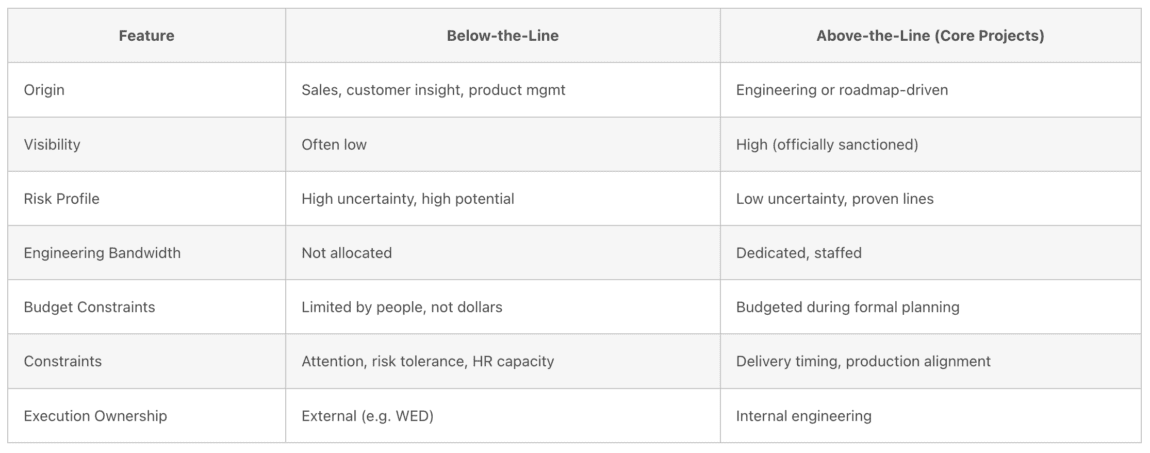“Below-the-line” projects refer to strategic new product opportunities that fall just below the threshold where internal engineering capacity ends. These are not low-value projects—in fact, they often offer significant long-term ROI, represent new markets, or satisfy unmet customer needs. However, because they originate outside the core engineering roadmap and exceed in-house bandwidth, they are deferred or dropped.
These projects often:
- Originate in sales or customer conversations.
- Are excluded by engineering capacity constraints, not business case weakness.
- Carry high risk, low initial certainty, and delayed returns.
- May open up entirely new product categories or market channels.
Outsourcing execution removes the artificial constraint imposed by internal capacity. Wolff Electronic Design (WED) exists to address this gap.
Definition:
Projects are ranked by expected ROI during planning. A figurative “line” is drawn to separate what engineering can handle from what it cannot. Projects above the line get approved and staffed. Projects below the line are deferred — not because of weak business justification, but due to bandwidth. These missed opportunities often hold meaningful ROI and strategic importance.
Roles and Information Flow
- Customer
- Identifies unmet needs.
- Communicates primarily with salesperson.
- Salesperson
- First internal recipient of new market signals.
- Brings early-stage opportunity to VP of Sales or Product Manager.
- Often retains best understanding of customer context.
- Product Manager
- Often sales-aligned, not engineering-aligned.
- Bridges customer needs and technical feasibility.
- Engages with engineering to scope solutions.
- May not deeply understand technical constraints but understands functional asks.
- VP of Sales / Executive Leadership
- Validates business viability.
- Decides whether to invest in exploratory work.
- May greenlight assignment of internal or external resources.
- Internal Engineering Team
- Focused on existing product lines.
- Optimized for incremental innovation (e.g., variants, extensions).
- Typically not incentivized or structured for high-risk development.
WED Role in Below-the-Line Projects
Strategic Position:
Wolff Electronic Design (WED) is not a staffing agency or general consultant. It is a fractional, external new product engineering team designed to fill the execution gap for projects that fall below the internal line of resourcing.
Functionality:
- Pre-Project Consulting
- Work with sales/product to define concept and feasibility.
- Convert informal or ambiguous asks into clear engineering requirements.
- Architecture and Definition
- Propose viable technical architectures.
- Define tradeoffs, BOM, cost structures, and timeline implications.
- Customer-Facing Bridge
- Interface with product managers to validate features with customers.
- Suggest improvements or alternatives that outperform initial visions.
- Execution Delivery
- Act as a turnkey engineering unit for new product delivery.
- Integrate cross-industry lessons while customizing for client brand.
- Non-Disruptive to Core Operations
- Operate outside internal engineering priority stack.
- Avoid disrupting in-flight, high-revenue programs.
Characteristics of Below-the-Line Projects

Strategic Advantage to Sales VP
By engaging with Wolff Electronic Design:
- Sales leaders can resurrect high-value opportunities that otherwise stall.
- Pursue new market solutions without disrupting existing workflows.
- Gain a technically competent partner who can define, validate, and build new systems.
- Operate in stealth mode until proof points are ready.
Messaging Summary for Sales Teams
- “Below the line” does not mean low priority—it means resource-constrained.
- These projects often have strong ROI and customer pull.
- WED is your mechanism to execute them without cannibalizing internal resources.
- Treat us as your drop-in new product development arm.
Work with Us
Let’s make your next project smoother, smarter, and on your terms, with our Engineering-as-a-Service on-demand contracting.
How EaaS Works:
- Access senior-level engineering support when and where you need it—from early scoping to mid-project troubleshooting or late-stage refinement.
- Our experienced team helps you define clear requirements, develop architecture, assess risk, and solve technical challenges—all without hiring full-time staff.
- Your hours are flexible: use them for consulting, system design, documentation, or to get back on track when priorities shift.
- You walk away with a clear, actionable path forward—whether you’re planning next steps or gearing up for production.
Work directly with our team today – click here to learn more about EaaS.


